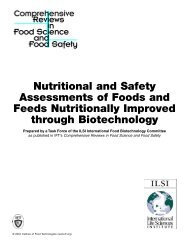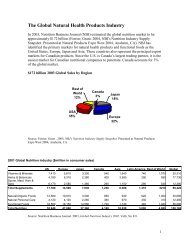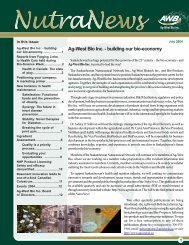Beyond Borders: Global biotechnology report 2010
Beyond Borders: Global biotechnology report 2010
Beyond Borders: Global biotechnology report 2010
Create successful ePaper yourself
Turn your PDF publications into a flip-book with our unique Google optimized e-Paper software.
Perspectives for the new normal<br />
Succeeding together<br />
Biotech and pharma companies have been partnering for<br />
decades, and people have been looking for the perfect<br />
pharma-biotech alliance structure for about as long. How do you<br />
truly maximize the strengths of each partner — biotech firms’<br />
entrepreneurship, nimbleness and research innovation and<br />
pharma companies’ financial, development and global marketing<br />
capabilities — without quashing what they do best?<br />
Many people would say that the closest the industry has<br />
come to a “perfect” formula is the original Roche-Genentech<br />
relationship, where Roche invested significant resources in<br />
Genentech but also gave it tremendous independence. Although<br />
that relationship was enormously productive and mutually<br />
beneficial, that structure has been relatively rare in our industry.<br />
For a big pharma to invest more than US$1 billion in a small<br />
company requires confidence in the company’s ability to deliver.<br />
And many small companies don’t fully appreciate how valuable<br />
big partners can be.<br />
Regeneron’s collaboration with sanofi-aventis to discover,<br />
develop and commercialize fully human monoclonal antibodies<br />
shares some elements with the Roche-Genentech alliance,<br />
and our experience may be instructive for other companies.<br />
Our collaboration first grew out of a 2003 alliance to develop<br />
a vascular endothelial growth factor (VEGF) trap for cancer.<br />
In 2007, sanofi-aventis decided to expand its <strong>biotechnology</strong><br />
presence, and — since we knew by then that we worked well<br />
together and had confidence in each other — we agreed to a<br />
new, five-year antibody collaboration. The deal terms provided<br />
that we would get about US$100 million a year for preclinical<br />
research on human monoclonal antibodies for a variety of<br />
targets. As the fruits of this research are ready to move into<br />
clinical trials, sanofi-aventis has the right to opt in to the<br />
co-development of the antibodies. Sanofi-aventis then generally<br />
funds all the development costs and we repay 50% of those<br />
costs out of our share of future profits. When products are<br />
commercialized, we are entitled to 50% of US profits and<br />
35%—45% of non-US profits.<br />
In 2009, after Chris Viehbacher became CEO, sanofi-aventis<br />
reviewed its relationships. By the end of 2009, we had already<br />
delivered on our original promise by putting five antibodies into<br />
clinical development in the first two years of the agreement.<br />
So sanofi-aventis proposed that we expand and extend our<br />
collaboration: they would provide us up to US$160 million a<br />
year for preclinical research, the funding would stretch out for<br />
10 years (through 2017), instead of the original five, and we<br />
16 <strong>Beyond</strong> borders <strong>Global</strong> <strong>biotechnology</strong> <strong>report</strong> <strong>2010</strong><br />
Leonard Schleifer, MD, PhD<br />
Regeneron Pharmaceuticals<br />
CEO<br />
would aim to advance an average of four to five antibodies into<br />
clinical development each year.<br />
This arrangement provides valuable stability because we can<br />
count on steady inflows of significant funding for the next eight<br />
years. This allows us to make the long-term investment in people<br />
and research and manufacturing infrastructure required to meet<br />
our commitments to sanofi-aventis. If we sustain the success<br />
rate we’ve had so far, we would move 32 to 40 candidates into<br />
clinical trials through this collaboration. Of course, building<br />
a pipeline that large — something only the biggest biotech<br />
companies can even dream of — is very expensive, but we<br />
have pre-negotiated funding for the enormous development<br />
program. By entering into one large collaboration rather than<br />
doing individual deals with several partners, we minimize the<br />
cost of executing and managing those relationships, as well<br />
as the complexity of joint governance. Importantly, we retain<br />
control over our discovery efforts, including which programs<br />
to prioritize. We also maintain an independent culture — Chris<br />
Viehbacher and I have no intention of “sanofizing” Regeneron.<br />
On the other hand, sanofi-aventis will take the lead and have<br />
the final say in commercialization decisions, where they have<br />
extensive expertise, experience and resources.<br />
Lessons for the new normal<br />
What lessons are there for firms considering Regeneron’s<br />
approach? First, companies will need to develop proprietary<br />
and scalable assets (the VelocImmune ® antibody technology<br />
platform, in our case) that allow them to leverage capabilities<br />
broadly. But it’s not just about selling a platform. We also hired<br />
world-class scientists and invested in managing and continually<br />
improving our platform.<br />
To find a partner willing to make a significant long-term<br />
commitment with an equitable sharing of decision-making,<br />
biotech firms will need to build mutual trust. Deal structure can<br />
help further align interests. While people talk about “win-win”<br />
deals, this is often really about trying to win while convincing<br />
the other side that they are going to win, i.e., “win-lose.” In our<br />
case, Regeneron can only succeed if sanofi-aventis succeeds,<br />
and vice-versa. That’s important, because now more than ever,<br />
we need successes — not just for companies and investors, but<br />
for the patients we ultimately serve.








